Munnar
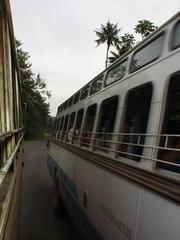 |
| Busses passing each other on the way to Munnar |
The bus ride from the plains of Kerala up to Munnar took my breath away: partly from awe at the view out the window, and partly from fear that the bus would drive off of the precipice that followed the right hand side of the road. Munnar in a town in the Western Ghats, the mountains that follow the southwestern coast of India, and is home to some of the highest tea growing estates in the world.
The road leading up to Munnar, like all of the roads in the Ghats that I have seen, was narrower than most American driveways and full of potholes. When it was necessary for two of the battered Kerala State Road Transportation busses to pass each other, their diesel engines would drop to a gutteral growl. The downhill bus would pull halfway off of the road and halt, and the uphill bus would slowly nuzzle past, less than a foot away. In some cases, there was no room on the shoulder for the downhill bus, so it would have to slowly, slowly back up, with the uphill bus following, until it could make way. Out the window the trunks of palm trees, less than a foot thick, rocketed up a hundred feet from the valley floor, exploding into a green burst of leafy fronds. Far below them short shrubby trees grew like oversized broccoli.
The last ten miles before arriving in Munnar, wisps of fog laced the hills, and the tea started. Tea grows on trees that are kept trimmed low, so that they look like bushes; in the Western Ghats, they grow those trees like Hoosiers grow corn. Unlike the Midwest, however, the topography of the Ghats gives vantage points that make it possible to more fully appreciate the magnitude of the agricultural enterprise taking place. The trees are organized into clusters just the right size for tea leaf pickers to be able to reach around them, leaving thin little pathways weaving between them. From on high, the effect is that of driving over an enormous green fish, its scaly side reaching out as far as the eye can see.
Upon arriving in Munnar, I stayed at the cottage of the garrulous and informative Joseph Iype. I asked him for a good walk around the area, and he drew out a map for me, leading from town to village and through the plantation of the stuttering Tata Tea Corporation. There was also cardamom, coffee, and a waterfall on the way. Joseph, like Jose on the Kanyakumari Express, explained his thoughts repetitively. As he drew the map, he explained each section of the path at least three times, and then had me recite it a fourth.
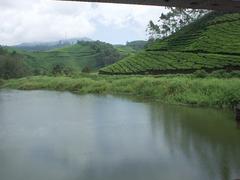 |
| Tea with lake in foreground, Munnar. |
The quality of his route was very good. The cardamom plantations have rows of banana plants, with enormous leaves that shelter the tiny cardamom plants below, which are little stalks lined with little spheres that hold the spice. The cardamom gave way to the village of Pothamedu. Kerala voted in the world’s first democratically elected communist government in 1956, and the peasants of Kothmanduy were a reflection of this: they were poor but well-educated; when I asked someone if I could take their picture, they would invariably say “yes” and then ask for a copy, writing down their address in impeccable handwriting.
Next came tea country. The long winding path dove into the green scales of the tea trees, with “tea ladies” (as Joseph called them) navigating the lanes betwen them and plucking tea. Up close, it was possible to see the age of the trees: they had orange and white lichens growing on their trunks and on the gnarled roots fastening them to the sloped ground. High quality tea trees - Darjeeling or Assam are the most common varieties - do not start producing until at least five years after plucking, but they can live for up to one hundred and fifty years. Later, a guide who was leading me through a part of the Ghats further north pointed out quick growing plants, much more spindly and frail, that he said could be harvested in two years but died in sixty.
About a mile into the plantation, a man passed me. He was Indian, but he had an intensity to him, unlike the usual carefree Indian manner.
“What is your good name?” he asked. This is the Indian way of asking for someone’s first name.
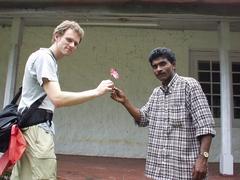 |
| Rajan, the Assistant Manager’s cook, hands me a flower. |
I told him. We went through the usual traveling pleasantries; I was from San Francisco, a computer programmer. His name was Rajan.
“Are you bachelor?” he asked.
“Yes.”
“So you are not married.”
“That’s right, not married. Are you?”
“Yes, married with two children. Come, where are you heading?”
“Athukad falls,” I said. It was the next big stop on Joseph’s map. “Is it very far?”
“Yes, one kilometer you go down and then - Athukad waterfall. But first you must come to my house. Perhaps, have some tea, and then you can go on to Athukad waterfall, yes?”
“Um, sure, but where is your house?”
“Just here, behind Assistant Manager Bungalow.” He pointed to a building a hundred yards up the hill. “So you do not have a wife?”
Was this not yet clear?
“NO I DO NOT HAVE A WIFE,” I said. “But how long does it take to walk to your house?” I had been led on one of these wild goose chases before in Mumbai and followed a fellow for almost an hour before we got to where we were going.
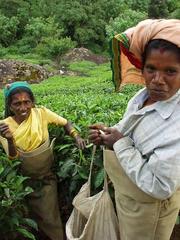 |
| Tea picking ladies, Tata tea plantation, Munnar. |
“Less than five minutes, no problem.”
Which probably means less than fifteen minutes if I’m lucky, I thought. But Rajan was honest; we were there in two minutes. On the way, he explained his occupation.
“I am Chinese cook. I went to Cochin to learn to be a Chinese cook. I make chop suey, egg foo young, vegetable stir fry, kung pow chicken, egg fried rice. I cook this for the Assistant Manager. This is his bungalow.”
We had arrived. Rajan led me past the Assistant Manager’s Bungalow sign and across the well-tended garden and over the immaculately manicured lawn, where there was a lawn manicurist hard at work. Rajan tried two doors on the bungalow, which were both bolted from inside. He asked something of the gardener in Tamil, who replied in kind; Rajan started to walk around the building, thought better of it, and jumped through a low window and unbolted the door. He gave me the tour: here is the dining room, with Chinese placemats; the guest bedroom, the Assistant Manager’s bedroom…
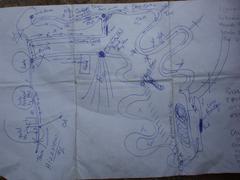 |
| Joseph Iype’s map of a 10K walk around Munnar. |
“Where is the Assistant Manager?” I asked.
“Ammm, Assistant Manager,” murmured Rajan.
“Yes, but where is he, where does he work?” I asked.
“Yes, Assistant Manager’s bungalow,” he said again. He had been able to understand my English just fine until now.
But my fears that we were invading the home of the Assistant Manager were laid to rest by the calm authority with which Rajan showed me around the kitchen. His kitchen. He flipped on the gas burners, and showed me the adjacent wood-burning stove, which was magnificent, but, according to Rajan, rarely used.
“Come, come, we go to my house. You have tea, and then to Athukad waterfall.”
We went. It was a small shack behind and below the main bungalow. Another man, more portly than Rajan, sat with three children in front. We walked inside, into a room with three beds tightly packed against each other; there was a tin roof, and on the walls there was a calendar and a large picture of Jesus with a flaming sacred heart. The other man came in and there was a brief discussion in Tamil involving the word “chai”, which means tea with sugar and milk. Two of the little girls followed us in, which Rajan introduced as his daughters. He told me their names, and then we ran out of things to say; it was awkwardly silent like a first date. I thought hard, searching for a topic of conversation.
“Where is your wife?” I finally asked.
“Wife is out for fireoota.”
“Fire what?”
“Fireoota, she is out for fireoota.”
“Ah.” I let it drop.
He pulled out pictures: wife, daughters, Rajan bathing with friends at a holy site, Rajan riding a tractor. The other man brought in the tea and walked out again.
“Who is he?” I asked.
“He is my assistant, he is chopping the vegetables.”
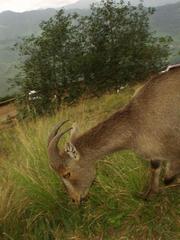 |
| An amazingly tame Nilgiri Tahr, Eravikulam National Park, Kerala. |
The Assistant Manager’s Cook’s Assistant. Only in a country with as many people to spare as India could one have such a title; and this was a full grown, middle aged man with a daughter. Earlier, I had also noticed how, in places where an American would store tools or supplies, Indians would add in an extra person or two to operate or distrubute whatever was in the storage space; usually the space wasn’t made any bigger, either. On the train, from Mumbai to Ernakulam there was a linen closet. Besides the linen, it also contained a hard bunk where two linen-dispensing men lived. At the Hotel Lawrence in Mumbai, next to the reception desk, there was a narrow room where two men slept and ate, with the mops, brooms, and spare sheets; they cooked, cleaned, sometimes manned reception, and kept the place running. At Nirav’s friend’s house, there were several servants who, according to Nirav, lived in the garage.
Rajan’s wife returned, as well as another woman, both with large bundles of thick sticks on their heads: gone for firewood, he had been trying to tell me.
It was time for me to go. Rajan walked me out and back towards the path I had been walking on. Before we parted, I wanted to take a picture with my digital camera, and I showed the result to him. This was tremendously exciting to immediately see his own picture. He wanted to show his wife. Pleading with me to not go for another minute or two, he bolted back the way we had come.
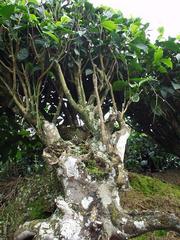 |
| Old tea plant, Munnar. |
She had left for more fireoota. Rajan consoled himself by arranging a photograph of him handing me a flower, which he had plucked from the Assistant Manager’s garden, and I kept walking on.
I passed what I imagined to be the Assistant Manager himself about a mile later. He looked like an Indian Scoutmaster: he wore khaki shorts, an Indiana Jones hat, a walking cane, and over-the-calf tan stockings, underneath one of which he appeared to have stuck some kind of small tool. I greeted him, and he replied with a baritone “Good Afternoon” worthy of James Earl Jones.
The waterfall was impressive, but there are many waterfalls in India. This does not seem to stop the Indians from admiring them all, however; there were many of them coming down in jeeps, full to the brim, from the dirt road ahead.
I had woken up that morning with a sore throat, and by now I was feeling feverish and miserable. I rested for ten minutes, watching a Indian tourists mill in front of Athukad Falls and gawk. After that, it was a long hike up an enormous stone stairwell to the main road. Schoolchildren streamed down from the top in groups of five to ten; almost every group asked me for “Pen-pen?” or “Chocolate?” and, having neither to spare, I refused them all. I was just about to start greeting each new group with “Hello, no pen, no chocolate,” when a small girl with pigtails tied up in pink ribbon walked boldly up to me and said, “Hello, how are you?”, shook my hand firmly, and went on her way. From the top road, I caught a shared jeep, one of the Mahindra Commanders that are a slightly inflated Indian version of a Jeep Wrangler.
That night my fever got worse. As I lay sweating in bed, I debated taking some of the doxycycline pills that I had for Lariam-resistant malaria in Thailand; they were also useful as a general antibiotic. They had worked to great effect in Mumbai against the bug that I caught from Nirav, for which he said he had been prescribed antibiotics; however, I had foolishly stopped taking them after I was feeling better only four days later. It was very likely that I was suffering from the same illness, only now possibly it was doxycycline resistant. I figured I had nothing to lose; if they were giving it out as an antibiotic to all Americans who were going to Thailand, I wouldn’t reduce its effectiveness too much more by taking it here. I gulped down two pills, the recommended initial dose.
I had read once about how someone had created a video game for pediatric cancer patients, in which they controlled little T-cells that go around telling cancer cells to kill themselves. That night, half-asleep and febrile, perhaps inspired by that invention, I imagined the battle going on inside my veins. Lumbering macrophages sent out pseudopodia, pulling in little clusters of spherical bacteria that swarmed around them. The ensnared bacteria screamed, with their little bacteria faces, until they were swallowed and dissolved. Some of the same white blood cells, bloated from consuming a surfeit of the enemy, lay broken and rotting. Overhead the sky was apocalyptic crimson; the surrounding terrain was as parched and scorched as my throat. Things were beginning to look grim: the enemy forces were dying by the score, but they were spawning even faster, and the cells of my immune system were hard pressed. On a cliff above the battlefield, there were a few little men in white lab coats with mirrors on their foreheads, like doctors from the 1950’s. They were loading two howitzers with turquoise shells that said “Mutual 105” on the side (for such was the color and labeling of the doxycycline pills). Kaboomf! Kaboomf! The howitzers recoiled and two parabolic lines streaked to the battlefield, exploding into turquoise haloes that spread across the combatants. The resulting devastation was, I think, inspired by the nuclear detonation in Terminator 2, which I still think is one of the most terrifying scenes produced by Hollywood: the little bacteria disintegrated before the crest of the shockwave, their cell walls melting quickly, leaving little puddles of endoplasm with ribosomes and DNA fragments in them. The macrophages paused as if in disbelief, for their prey was suddenly missing. The sky began shifting to blue; clouds moved in and it started pouring rain.
I sat up, drenched in sweat; my fever had broken. It was six a.m. I slept for two more hours until a gentle rapping at my door woke me up. It was Joseph.
“You are feeling better?” he asked.
“Yes… yes, I think so.”
“The three Germans who are next door, they are hiring a car to drive around and see the National Park, a tea factory, and some other things in the area. You want to go?”
I went. The Germans were named Martin, Peter, and Rheinhold. They were, predictably, engineers, and at breakfast, when I ordered a poori masala, they ordered “toast butter jam” to a man, only differing in their beverages: tea for Martin, milk tea for Peter, and coffee for Rheinhold. They all spoke English well, and I settled two bets while we ate: “backbag” was not an acceptable synonym for “backpack”, and “cancel” was, in fact, the correct verb for what a mailman does to a stamp.
We drove to Ervikulam National Park (entrance sign: “This is the habitat of wild denizens Seeing animals is a matter of chance”), home of the staggeringly tame Nilgiri Tahr. It was possible to walk within ten feet of them, at which point they would walk away. They only ate grass, so it seemed unlikely that the tameness came from them being fed. I was surprised that they had survived this long. After that it was a crocodile farm; it was not entirely clear why the state of Tamil Nadu (for we had driven over the border from Kerala at this point) was growing the fifteen-foot man eaters, but presumably they were endangered.
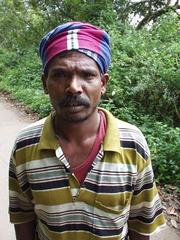 |
| One of the men who pointed out the caterpillars are poisonous. |
We stopped in at the Talliar tea factory, where we saw tea being processed; this was mostly lower grades, that were dried, chopped, the stems and veins removed by static electricity, fermented, and sorted by grade by a large vibrating chute with wire mesh of descending size lower down; little waterfalls of tea fell from the side of it into large tin bowls. Huge mounds of tea, as fine black powder, were on the floor, and there were rows and rows of canvas sacks that were filled with it. A week later, I saw another factory, where they showed us (non-operating) machinery that processed whole-leaf tea, for the highest grades, but that was not in evidence here.
The day ended with a stop at the Chinnar Wildlife park, which had a rickety thirty foot tower from which it was possible to see tiny little specks of wild pigs, deer, and a trumpeting herd of wild elephants. We retuned to Joseph’s cabin; I bid farewell to the Germans, and packed my bags to go to Kodaikanal, still in the Ghats, but to the southeast.